Improving health and social care service resilience over public holidays: data analysis
This supplementary report shows relevant data analysis and intelligence to underpin the deliberations and findings of the public holiday review.
5 What we learn from national evidence
5.1 NHS 24
NHS 24 receives calls 24 hours of the day, seven days a week. An analysis of the number of calls each day shows clearly the distinctive pattern of call volumes with a regular increase in calls evident at weekends (Chart 1). It also shows the distinctive pattern during the Christmas and New Year holiday periods. Specifically the chart shows the daily picture during the month of December and early January in 2016/17 when Christmas Day and New Year’s Day fell on a Sunday. The distinctive pattern begins on the Saturday before, with higher volumes occurring compared to a typical weekend. The two days after Christmas Day and New Year’s Day, a Monday and Tuesday, are markedly different from the typical Monday and Tuesday during these winter months and are at levels higher than experienced during a typical weekend.
Chart 1
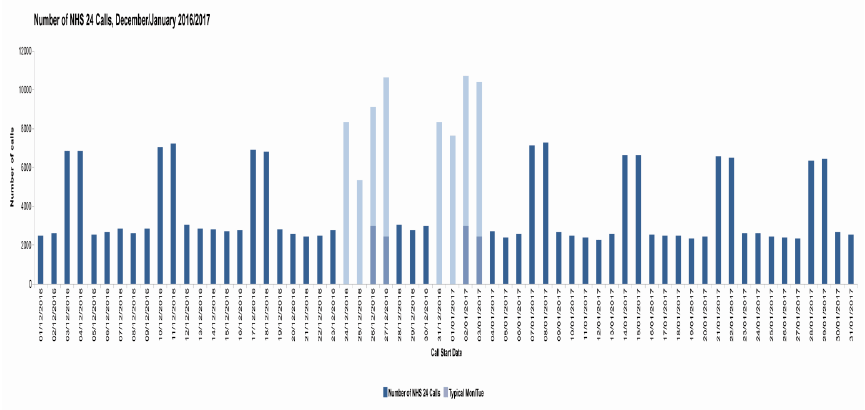
It not unreasonable to assume that this increased number of calls can largely be explained by the limited availability or closure of primary care services during the 4 days of each holiday period.
These extra calls to NHS 24 then translate into a pattern of increased contacts with (mainly) Primary Care Out of Hours ( PC OOH), as evidenced in Chart 2 below.
Proportionally more patients calling NHS 24 are being referred to PC OOH during these holiday periods than during a typical weekend. Following contact with NHS 24 marginally less people are advised to attend A&E or have an ambulance called during public holidays. This is demonstrated by comparing a typical weekend day when around 20,830 calls are made to NHS 24. Of those, just over half (around 10,790 calls) resulted in the patient being referred to PC OOH. On Christmas Day 2016, there were 36,015 calls to NHS 24 and of these 6 out of 10 patients (21,511) were referred to PC OOH.
Chart 2
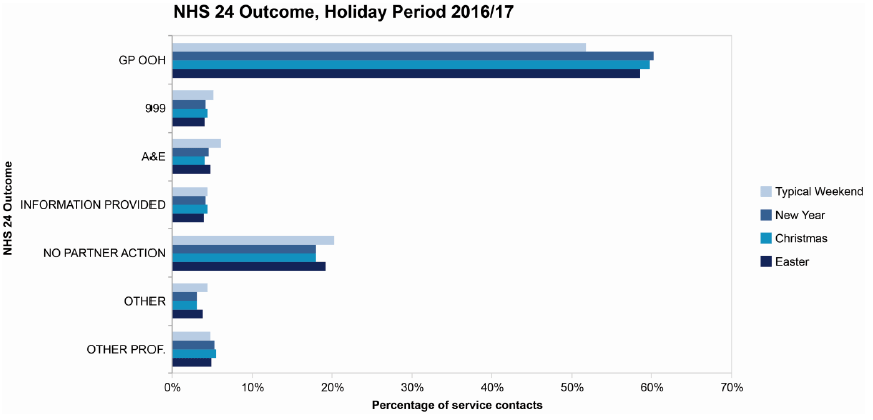
5.2 Primary Care Out of Hours ( PC OOH)
5.2.1 The pattern of referrals to PC OOH corresponds closely to that experienced by NHS 24 – for example a marked increase on the Saturday before Christmas compared to a typical Saturday - and the following Monday and Tuesday experiencing a markedly higher level of activity even compared with a typical weekend (Chart 3).
Chart 3
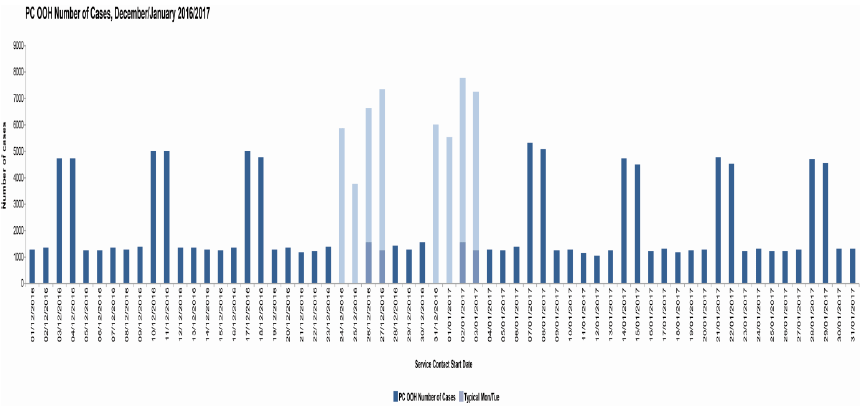
5.2.2 Alongside the absolute increase in number of people treated by PC OOH services is an increase in the time taken for patients to be seen, irrespective of whether at home or at a Urgent Care Centre. The two charts (4a and b) below show the distribution of time to see the patient in the two settings. The curves further to the right of the typical weekend curve signify a longer wait. In summary there is nearly an extra hour added to the wait for some patients compared with a typical weekend, though very urgent cases will be prioritised and seen quickly.
Chart 4a
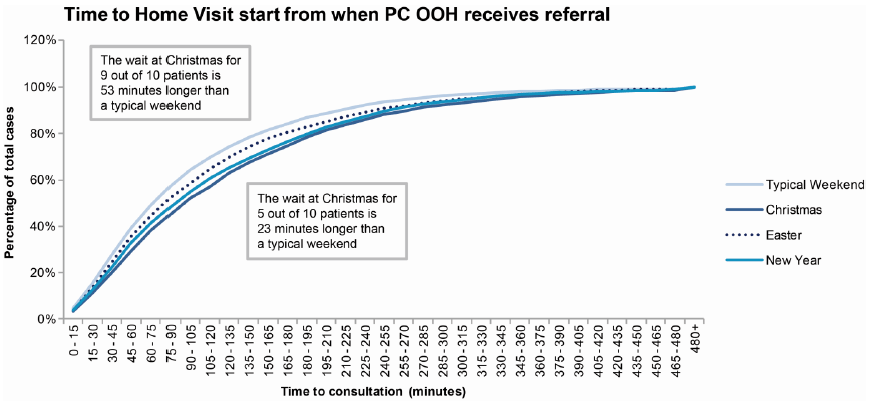
Chart 4b shows the additional wait experienced by patients attending Urgent Care Centres.
Chart 4b
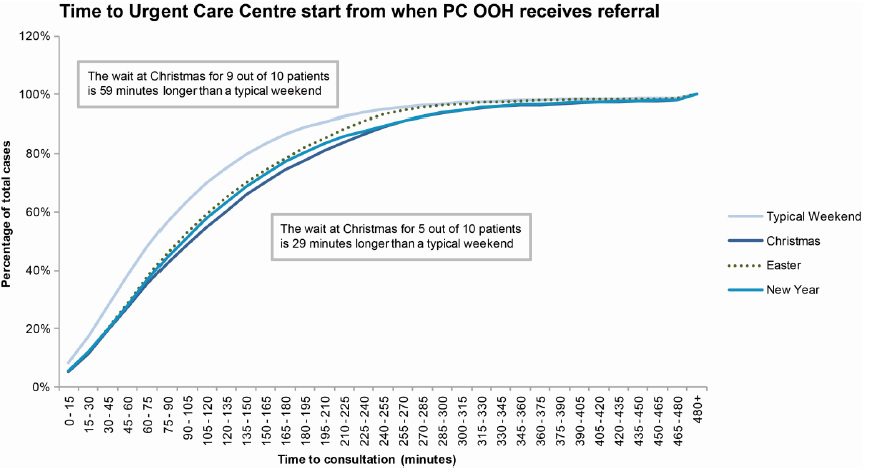
5.2.3 The Public Holiday Review Report stresses that its Key Messages apply to both physical and mental illness services. It is has been suggested that acute mental health presentations are more common around the Christmas and New Year period. Chart 5 shows the pattern in the recorded diagnoses of anxiety and stress for PC OOH. Chart 5 indicates that these presentations appear to higher earlier in December and later in January than apparent during the immediate festive period. However this simple analysis may mask variation in the complexity and intensity of anxiety and stress and further work is required to elucidate this.
Chart 5
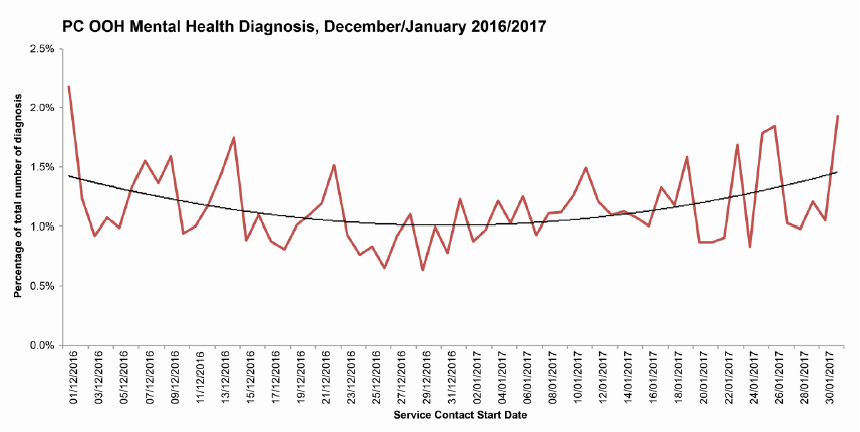
5.3 Prescribing
5.3.1 The general trend in prescribing items continues to increase. In 2007/08 the total number of items dispensed across Scotland was just over 80 million, in 2016/17 this had increased to over 100 million. More information is available here.
5.3.2 Although the reasons for a different pattern in the timing of prescriptions can’t be ascertained from present available data, it is interesting to observe the marked rise in the number of patients prescribed antibiotics by GPs in hours in the week before Christmas (Chart 6). This is likely to be people going to see their GP as they don’t want to be ill over Christmas. The daily numbers are also higher than normal during the (fewer) in hours days between Christmas and the New Year and the week after New Year.
Chart 6
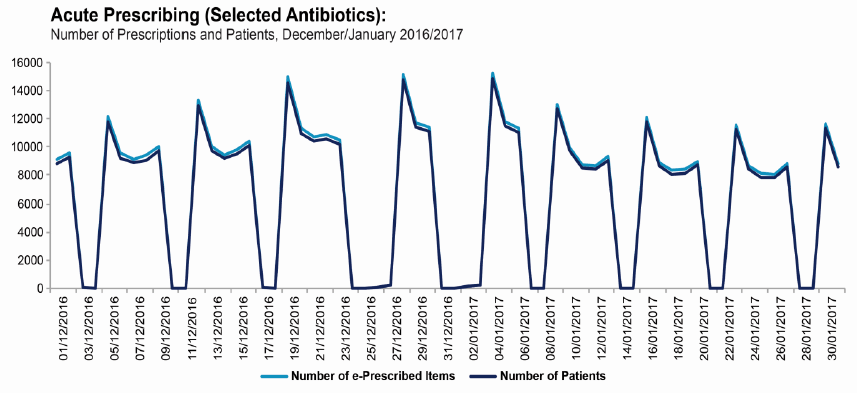
5.3.3 Usage of Minor Ailments Service
A broadly similar pattern is observed in the use of the Minor Ailments Service ( MAS) by the public (Chart 7). In the run-up to the festive period this service is more heavily used compared to normal usage. However, the data show that during days three and four of both Christmas and New Year public holidays, fewer people are using this service. This may be due to a number of pharmacies operating reduced opening hours or will be closed, therefore access will be reduced.
Chart 7
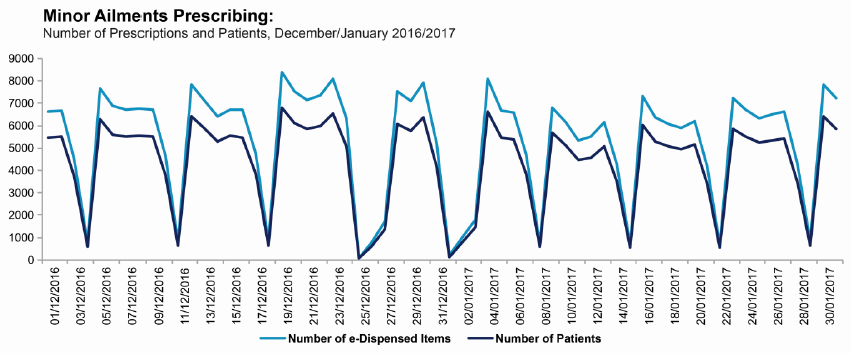
The medicines that are most commonly dispensed via the MAS, are listed in Chart 8. Most of the items that are in the top ten (paracetamol significantly the highest by volume), are similar to dispensing patterns for the rest of the year.
Chart 8
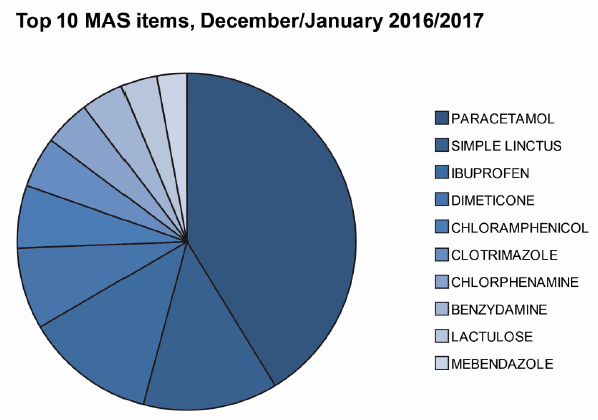
5.4 Scottish Ambulance Service ( SAS)
5.4.1 It is useful to look at the way that the SAS daily demand pattern may differs, over the course of extended holiday periods. While there is no marked difference overall in activity on Christmas Day and the Saturday preceding, there is a marked rise in demand after Christmas, especially on the day after Boxing day, compared with a typical day (Chart 9). At the New Year holiday, 1 January is by far the busiest day for incidents though most of this occurs in the early hours of New Year’s day.
Chart 9
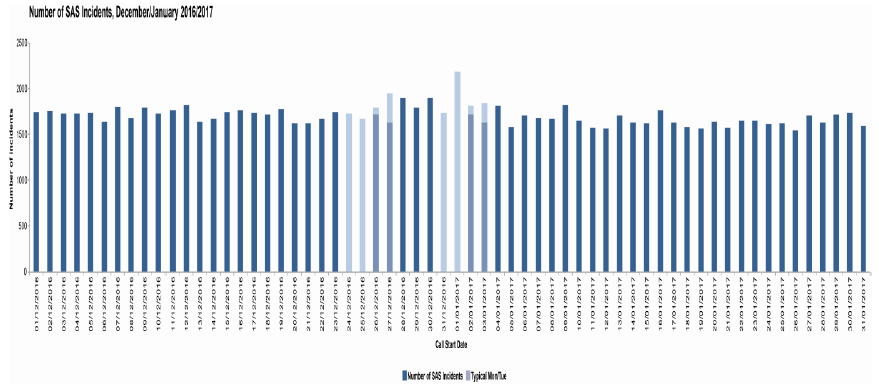
5.4.2 The following data has been provided from the Scottish Ambulance Service clinical system. A proportionately high number of incidents are experienced during the early hours of New Year’s day as evidenced in Chart 10a.
Chart 10a
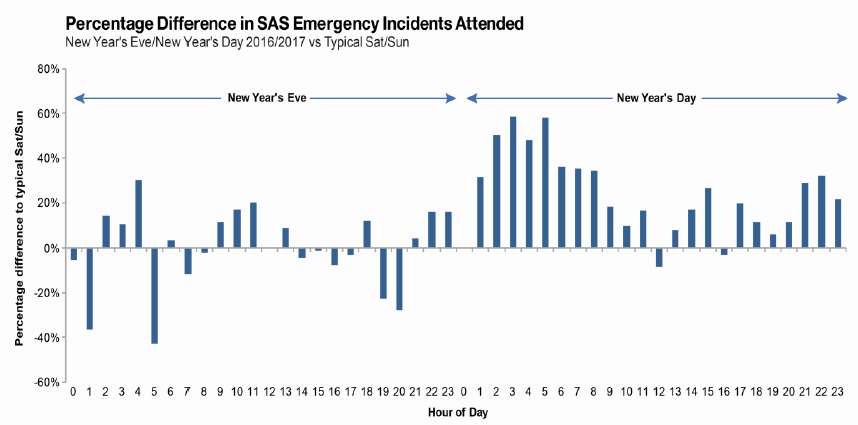
The paramedics will record if they suspect that alcohol is in involved whilst attending an incident. While the recording of alcohol related problems is generally undercounted the available data reveal a pattern that is striking: a 21% rise on New Year’s Eve and a 53% rise on New Year’s Day, Chart10b.
Chart 10b
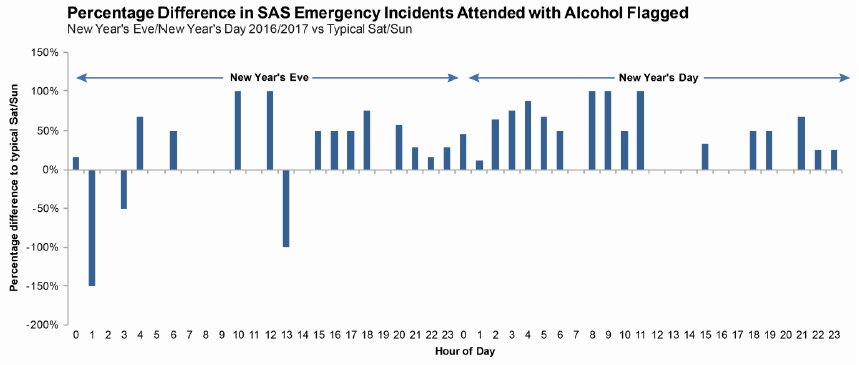
5.5 Accident and Emergency Services
5.5.1 At A&E services, the number of people attending reduces gradually in the five days leading up to Christmas. During the days immediately following Christmas, numbers return to the more typical pattern (Chart 11). Numbers rise again from New Year’s Day before returning to the typical pattern a few days later.
Chart 11
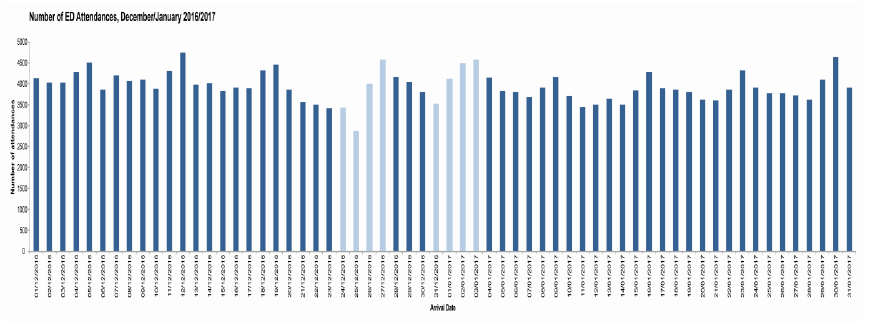
5.5.2 The chart below suggests that the time to be discharge, admit or transfer a patient in A&E, at both Christmas/New Year and Easter holidays is similar to a typical weekend (Chart 12). The data for the New Year period show that on average patients attending A&E wait 30 minutes longer before being admitted, transferred or discharged compared to a typical weekend.
Chart 12
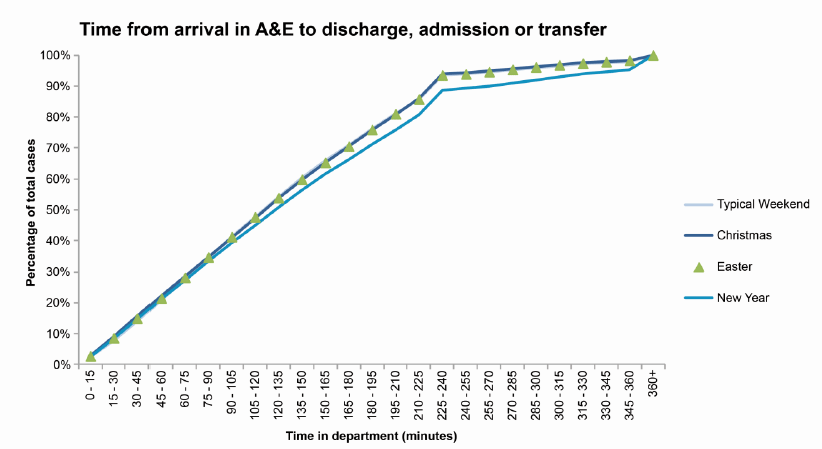
5.5.3 Chart 13 presents information on discharge destination following A&E attendances. It shows that in 2016/17 (a similar pattern existed in 2015/16) a slightly higher proportion of patients attending A&E were admitted to hospital during the Christmas and New Year periods overall, than during a typical weekend.
Chart 13
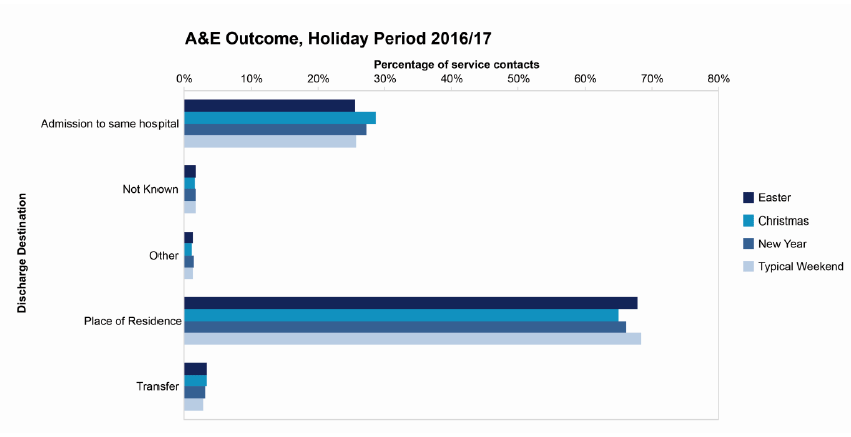
5.6 Emergency Admissions/discharges
5.6.1 The 2016/17 trend analysis in Chart 14 shows that the number of discharges from hospital peaks on the Friday before Christmas and on the Friday before New Year. Inspection of previous years’ data shows that this sharp increase in discharges is typical the day before Christmas and New Year.
Emergency admissions drop over the Christmas holiday period. When general practices reopen following a four day break, admissions to hospital increase steadily before dropping again over the New Year period. Chart 14 illustrates how the relative numbers of admissions and discharges varies during the Christmas and New Year festive period for 2016/17.
Chart 14
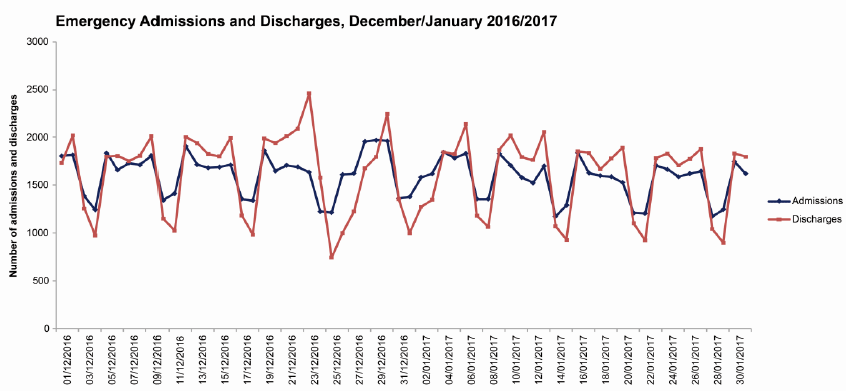
5.6.2 During a typical week there are around 12,000 planned (ie non-emergency) admissions to day-case and inpatient facilities in Scotland’s hospitals. Over the period between Christmas Day and New Year’s day, this is reduced to around 6,000 planned admissions per week. This is likely because hospitals adjust for the holidays and ensure that there is capacity available for emergency and urgent care.
5.6.3 There is variation in the average length of stay according to the day of the week that people are admitted to hospital in the period around the Christmas and New Year holiday. This variation occurs throughout the rest of the year. Compared with the period either side of the festive holidays a patient admitted as an emergency on Christmas Eve, Christmas Day and New Year’s Eve can expect to be in hospital around 1 day longer on average.
Chart 15
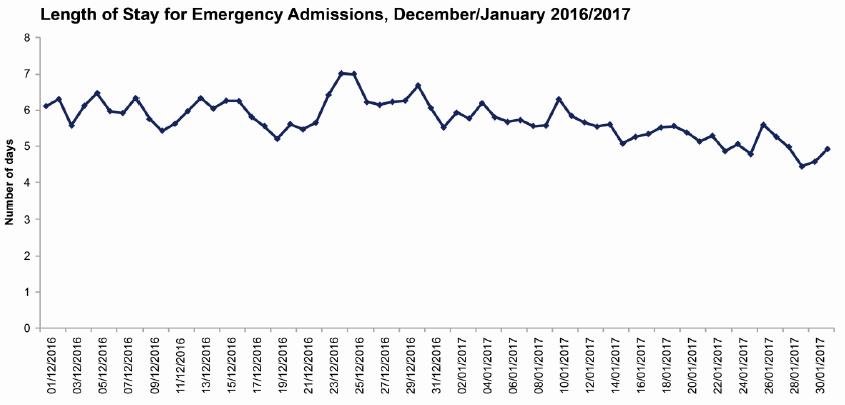
5.6.4 As a corollary to this analysis it is instructive to look at the variation in length of stay by day of admission at other times of the year. An analysis of four months (July to October 2016) of emergency admissions for the main acute hospitals in Scotland, shows that the percentage of patients who are admitted on a Thursday or a Friday is higher than the percentage who were admitted on a Monday or Tuesday and have a longer length of stay (Chart 16). There may be many individual reasons for this variation, including the impact of the weekend on the likelihood of discharge.
The admission and discharge patterns for children are very similar to those above.
Chart 16
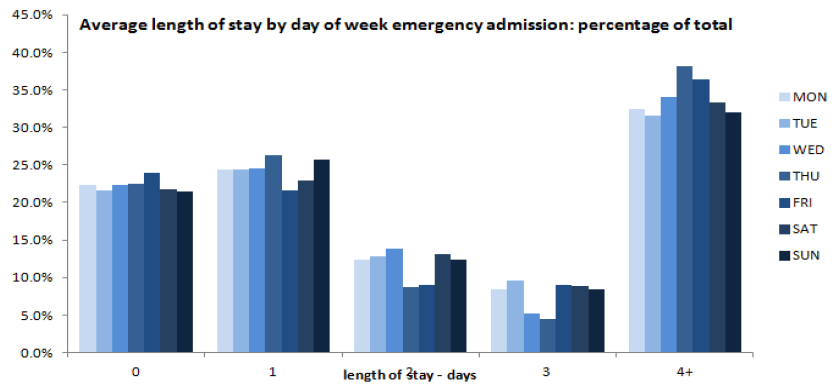
Contact
There is a problem
Thanks for your feedback